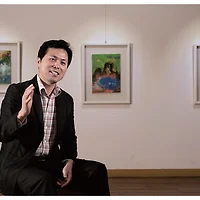Regaining luck and flying misfortune away
The traditional kites of Korea
Wingless men always long to fly higher and further. Kites resemble that desire. Kites can cross and surge through the blue sky. The traditional kites of Korea are especially swift, darting horizontally as deftly as vertically. Let’s take a look at the dignified images of traditional kites, which long for the well-being of Korea and Korean families.
Writer Kim Ha-neul
Photographer Jang Hyeon-seon
Kites can easily be found in fields or on the waterside. Throughout time, kites have been the symbol of freedom. Looking at kites tirelessly swim up the blue sky liberates hearts. These same charms apply to traditional Korean kites without exception. From their origin, the traditional kites of Korea talk of the desperate wishes of the people. Samguksagi, one of the most famous books in Korean history, describes the origin of Korean kites as follows.
“On the first year of Queen Jindeok’s reign of Silla, Bidamyeomjong broke out in revolt, and General Kim Yu-sin took charge of suppressing the revolt. One day, a big star fell from the sky. It was an omen of the Queen’s defeat. Naturally, the public sentiment became restless. Being loyal to the Queen, General Kim secretly made a big kite and set it on fire. Then, he flew the kite up into the sky and told the people that the Queen will prevail since the star has risen back up to the sky. The public settled down. The morale of the Queen’s army rose, and they won the battle against Bidamyeomjong.”
The story of Korean kites continues into Goryeo Dynasty.
“When General Choi Young suppressed the rebellion of Mongolia in late Goryeo Dynasty, he set a kite on fire and flew it towards the fortress of the enemy to spread the fire to the fortress. He also took over the fortress by making his soldiers fly on a kite to infiltrate the fortress.”
Korean kites also appear during the Joseon Dynasty. According to ‘Nanjungilgi,’ a wartime journal written by Admiral Lee Sun-shin, kites were used to communicate with friendly forces on nearby islands when fighting the Japanese military at sea. Later, they were also used as weapons.
King Yeongjo of the Joseon Dynasty enjoyed flying kites. Furthermore, he nationally encouraged his people to fly kites. It is said that kite-flying became a popular folk game enjoyed by people of all kinds throughout the year, and that the number of kites was enormous.
Kites appear in the traditional customs of Korea. In old times, people believed that keeping a traditional kite in the house could repel misfortune and bring happiness. The ‘kite to avert evils’ was used in Daeboreum, which is the day of the first full moon of the lunar year. In this custom, it was believed that the misfortune of a year could be repelled by writing the names and birth dates of family members on a kite and flying it high in the sky.
Today in Korea, there are still many kite-flying contests with the significance of old times. They include Yongin (Gyeonggi-do), where the Korean Folk Village is located, and Chungmu (Gyeongsangnam-do). Many kite-flying contests and festivals are held throughout the country to celebrate Daeboreum.
Traditional Korean kites have been passed down successfully over generations. One reason for this is in the very characteristics of the kites themselves. The method of flying Korean kites, bound to a string, is the same as in the West. What is unique about traditional Korean kites is that they move up, down, left and right.
Kite expert Gwon Ik-jae of the Traditional Kite Preservation Association says, “The dynamics of traditional kites are outstanding. They can be freely controlled from the ground to move up, down, left and right. This gives traditional kites a variety of spectrums and rhythms, one of the reasons why people around the world acknowledge the merits of traditional kites of Korea.”
These merits and charms originate in the process of making them. The Bangpae (shield) kite, a type of traditional kites, has a circular window inside. This is a unique structure not found in Western kites.
Kite expert Gwon says, “This circular window controls the strength of the wind applied to the kite as well as the kite’s flying direction. During kite fighting, it also controls the force of defense and offense.”
Another characteristic of traditional kites determined during the manufacturing process is the kite’s dimensions. To make the kite fly higher or endure better during kite fighting, the ratio of the kite itself must be studied, just like studying mathematics. Also, it takes physical stamina to fly a kite and control it well. For such reasons, flying traditional kites have educational effects on children and youths.
Another characteristic of traditional kites is that they come in all varieties. There are more than a hundred kinds of traditional kites. The traditional kites of Korea are classified by shape and pattern. More than 99% of traditional kites fall into three categories by shape: the rectangular Bangpae kite, the long-tailed Gaori (stingray) kite, which children love to fly, and the creative kite made in the shape of a human or animals. The main characteristic of a Bangpae kite is that it has a hole (or window) in the center. Bangpae kites can be classified again into eight categories following the patterns and colors of their design, picture, letter and paper. As time passes, it is natural to see kites with new shapes and forms, kites that deviate from set formats. Each region of Korea has decorated their skies with unique kites which have changed through the flow of time.
Some of these unique kites include Guripalgwae kites, which have fronts divided into eight sections that are colored or have colored paper pasted to them; Osaek (five-color) kites, which have fronts divided into five sections and are colored in blue, red, yellow, black and white; and Doljjeogwi (hinge) kites, which are made of four-colored paper with corners attached in an X shape. There are also Gogibineul (fish scale) kites, which have a fish-scale pattern on front; Gaori kites, in a diamond shape, and Muneo (octopus) kites, with a fan shape. The shapes of these kites can be easily found in everyday life, resembling the various images of traditional kites.











